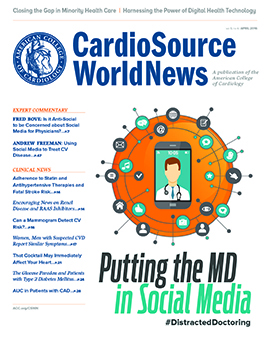Business Consult: Making Sense of MACRA
CardioSource WorldNews | By Dave Wofford, Senior Manager, ECG Management Consultants and Kevin Contorno, Senior Consultant, ECG Management Consultants
The April 2015 signing of the Medicare Access and CHIP Reauthorization Act (MACRA) represented the most sweeping set of changes to Medicare’s physician payment methodology in more than 2 decades. The bipartisan legislation repealed the sustainable growth rate (SGR), as well as planned cuts to the Medicare Physician Fee Schedule (PFS). In doing so, MACRA stabilizes updates to the Medicare PFS for the next 10 years and establishes new incentives based on physician performance. Physicians and hospitals that understand the implications of MACRA will be better positioned to act now in order to achieve future success in a post-MACRA reimbursement environment.
A Quick Overview
How does MACRA work? During the next 5 years, CMS will roll out a two-track system composed of the Merit-Based Incentive Payment System (MIPS) and alternative payment models (APMs), each of which is intended to align incentive payments with outcomes.
Let’s start with the Merit-Based Incentive Payment System, otherwise called MIPS. The MIPS track resembles the existing Medicare PFS. Fee-for-service (FFS) payments will remain virtually flat over the long term, while upside and downside risk payments will be incorporated based on physician performance in four categories, as shown in the table.
Under MIPS, the amount of FFS payments at risk will increase over time, reaching a maximum downside potential in 2022 of 9% (FIGURE 1). If you perform poorly, prepare to pay the price, as downside penalties will pay for upside bonuses.
The second track involves alternative payment models, or APMs, such as accountable care organizations (ACOs) and patient-centered medical homes (PCMHs). Compared to MIPS, APMs allow providers to accept more risk with the possibility of greater rewards. Participation comes with an annual service bonus of 5% for the first 5 years, as well as a higher accumulative payment update (0.75%) beginning in 2026. These incentives are designed to move providers away from FFS toward APMs, a transition that can occur gradually. To qualify for this track, a minimum percentage of a provider’s Medicare revenue must be received via APMs in a given year (FIGURE 2, on page 46).
Implications
It’s critical for providers to understand the implications of MACRA in order to prepare for the future challenges this act will entail. Specifically, MACRA will likely impact physician compensation and hospital/physician relationships.
Under MACRA, providers will attempt to align physician compensation structures with new methods of reimbursement. However, several factors will make it difficult for providers to tie individual physician compensation to performance under MIPS.
Aged Data for Incentive Compensation
Programs similar to MIPS indicate there could be significant delays between actual provider performance and receipt of MIPS payment. Additionally, performance under MIPS is identified at the provider level (tax identification number), not the individual physician level (National Provider Identifier), meaning providers can be rewarded or penalized for the performance of physicians who no longer work at their practice.
Complex Incentives
Based on the variation of existing PQRS measures (281 potential metrics) and the plethora of physician specialties, MIPS will almost certainly involve a complex incentive reporting formula, creating considerable uncertainty regarding physician reimbursement.
Physician Influence Over Incentive Measures
Resource utilization measures may take into account metrics that are outside the control of individual physicians. Conversely, a focus on metrics for which physicians have direct control may result in changes to referral patterns, decreasing compensation for physicians who are unable to meet the new cost containment goals of certain providers (e.g., specialists who order an inordinate number of cardiac catheterizations).
MACRA also presents significant implications for the relationships between physicians and hospitals. Both the MIPS and APM payment tracks will require that providers establish substantial resources and infrastructure in order to develop the systems and capacity to manage cost and demonstrate quality. Intensifying financial pressures will be experienced most by independent physicians. As a result, recent trends of increasing physician integration (e.g., employment, PSAs) and practice consolidation will likely continue as provider organizations seek to build the scale necessary to control spending under APMs.
Start Planning for MACRA Now
While MACRA continues to evolve, providers should be mindful of the adjustments to the Medicare payment system and the effect on the role of physicians in healthcare delivery. MACRA is bringing significant changes that will be experienced by many, regardless of whether you are on the provider or physician side. There’s a lot that organizations and physicians need to do in order to properly position themselves for payment reform—because although the full impact of MACRA may not be felt for years, the time to prepare is now.
For more information about MACRA contact Dave Wofford at dwofford@ecgmc.com.
Reference:
- Letter dated Nov. 17, 2015, from James Madara, MD, Executive Vice President and CEO of the AMA, to Andrew Slavitt, Acting Administrator of CMS.

|
Read the full April issue of CardioSource WorldNews at ACC.org/CSWN |
Keywords: Fee Schedules, Health Expenditures, Medicare, Motivation, Physicians, CardioSource WorldNews
< Back to Listings
